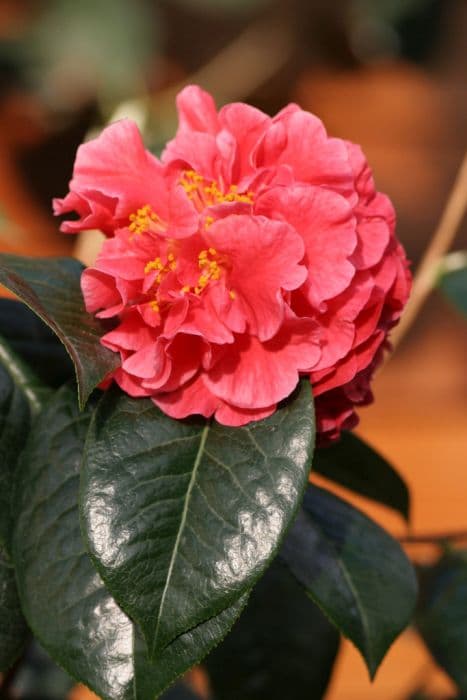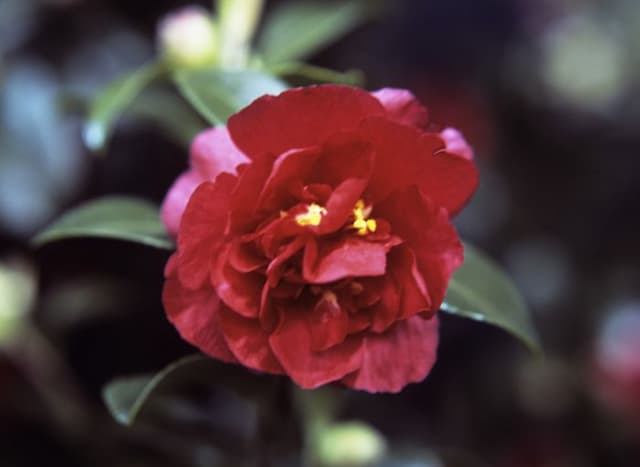Camellia Camellia 'Tom Knudsen' (japonica × reticulata)

ABOUT
The Camellia 'Tom Knudsen' is a striking flowering plant that is a hybrid, combining features of both its parent species to create a visually appealing appearance. This plant blooms abundantly with large, showy flowers that make it a standout in any garden setting. The flowers are uniquely formed with a double set of petals, which means that each blossom is packed with layers of petals, giving it a very lush and full look. The color of the flowers is a dramatic deep red, a hue that is both rich and velvety, drawing the eye and adding a touch of elegance wherever it is planted. Its petals have a smooth and almost glossy texture, which further accentuates the deep coloration. The flowers are nestled amongst glossy green leaves that provide a lush backdrop to the bright blooms, highlighting their beauty. Its foliage consists of leathery leaves that have a classic oval shape with pointed tips and serrated edges. The leaves themselves are deep green with a shiny surface, which stands in stark contrast to the luxurious red flowers, making the blooms even more pronounced. Overall, the Camellia 'Tom Knudsen' is highly prized for its ornamental flowers as they exude a sense of sophistication and are commonly used both in the garden for visual interest and as cut flowers for indoor decoration due to their attractive appearance and lasting qualities.
About this plant
 Names
NamesFamily
Theaceae.
Synonyms
Tom Knudsen Camellia, Japanese Camellia, Reticulated Camellia.
Common names
Camellia 'Tom Knudsen' (japonica × reticulata)
 Toxicity
ToxicityTo humans
Camellias, including the Camellia 'Tom Knudsen' variety, are generally considered non-toxic to humans. They do not typically cause poisoning when touched or ingested. Therefore, there is no specific symptom associated with the toxicity of this plant because it is not known to be poisonous to humans.
To pets
Camellias, including the Camellia 'Tom Knudsen' variety, are also generally considered non-toxic to pets such as cats and dogs. It is unlikely that ingestion of camellia leaves or flowers will lead to poisoning or severe symptoms in pets. As with humans, there are no specific symptoms associated with camellia toxicity because they are not considered dangerous to pets when ingested. However, gastrointestinal upset can occasionally occur if a pet eats a large amount of plant material, which is a common reaction to the ingestion of non-food items rather than a specific toxicity.
 Characteristics
CharacteristicsLife cycle
Perennials
Foliage type
Evergreen
Color of leaves
Green
Flower color
Red
Height
6-10 feet (1.8-3 meters)
Spread
5-7 feet (1.5-2.1 meters)
Plant type
Shrub
Hardiness zones
7-9
Native area
Japan China
Benefits
 General Benefits
General Benefits- Aesthetic Appeal: The Camellia 'Tom Knudsen' (Camellia) is known for its large, showy flowers that can provide a stunning visual display in any garden or landscape setting.
- Seasonal Interest: With its blooming season typically in the winter to spring months, it offers color and interest during a time when many other plants are dormant.
- Landscape Versatility: The Camellia can be used in various landscape applications, including as a specimen plant, in mixed borders, and as part of a formal or informal hedge.
- Habitat for Wildlife: The flowers provide nectar for pollinators, while the dense foliage can offer shelter and nesting sites for birds.
- Longevity: Camellias are known to be long-lived plants, sometimes surviving for several decades, providing lasting value to a garden.
- Shade Tolerance: This plant can grow well in partial shade conditions, making it suitable for underplanting beneath taller trees or in shady garden corners.
 Medical Properties
Medical PropertiesThis plant is not used for medical purposes.
 Air-purifying Qualities
Air-purifying QualitiesThis plant is not specifically known for air purifying qualities.
 Other Uses
Other Uses- Camellia leaves can be used as a natural dye, imparting a range of green hues to fabrics.
- The seed oil from Camellias is a nutritious cooking oil that's been used for centuries in Asia.
- The petals of Camellia flowers are edible and can be used to garnish salads or desserts for an elegant touch.
- Camellia wood, being hard and dense, is suitable for making high-quality woodworking tools and cutlery handles.
- Dried and pulverized Camellia petals can serve as a coloring agent for cosmetics, such as blush or eyeshadow.
- Camellia leaves can be added to compost or used as mulch, providing essential nutrients as they decompose.
- The flowers can act as natural indicators for pH balance, changing colors depending on the acidity or alkalinity of the materials they contact.
- Camellias can be trained and pruned into elaborate topiary shapes for decorative landscaping.
- The spent blooms and excess plant material make for good livestock feed, as they are high in protein.
- Camellias can be used in artistic floral arrangements and Ikebana, the Japanese art of flower arrangement, where they symbolize love, admiration, and perfection.
Interesting Facts
 Feng Shui
Feng ShuiThe Camellia is not used in Feng Shui practice.
 Zodiac Sign Compitability
Zodiac Sign CompitabilityThe Camellia is not used in astrology practice.
 Plant Symbolism
Plant Symbolism- Adoration and Devotion: The Camellia flower, being exquisite and long-blooming, symbolizes deep adoration and devotion between partners, making it a popular gift in romantic contexts.
- Perfection and Excellence: With its perfect, symmetrical form and lush petals, the Camellia represents the pursuit of perfection and excellence in one's endeavors.
- Longevity and Faithfulness: The robust nature of the Camellia, particularly its ability to grow for years and bloom each season, signifies enduring commitment and steadfast faithfulness in relationships or principles.
- Elegance and Dignity: The Camellia's dignified presence and elegant appearance make it a symbol of refined beauty, often associated with a dignified stature in society or personal grace.
- Deep Desire: The rich colors and velvety petals of the Camellia are indicative of deep passion and desire, thus making it a symbol of strong emotional and sensual connections.
 Water
WaterCamellias require regular watering to keep the soil moist, but not soggy. For a Camellia 'Tom Knudsen', it's best to water with about 1 inch of water every week, especially during dry periods. Adjust the watering frequency depending on the weather; they may need more frequent watering during hot, dry spells and less during cool, wet periods. Always water at the base of the plant to avoid wetting the foliage as this can lead to fungal diseases. It's crucial to have well-draining soil to prevent root rot, so ensure any excess water can escape.
 Light
LightCamellia 'Tom Knudsen' thrives in partial shade to dappled sunlight. It's best placed in a location that receives morning light and is protected from the hot afternoon sun. These light conditions help the flowers last longer and preserve their vibrant colors. Ensure the plant is situated in a spot where it is shielded from harsh winds, which can damage the leaves and blooms.
 Temperature
TemperatureCamellia 'Tom Knudsen' prefers a temperate climate with conditions that avoid extremes. The ideal temperature range is between 68°F and 75°F. However, it can tolerate temperatures as low as the mid-20s°F for brief periods. Protecting the plant from cold drafts and providing insulation during unexpected cold snaps is recommended to prevent damage to the buds and flowers.
 Pruning
PruningPrune Camellia 'Tom Knudsen' to maintain its shape and remove any dead or weak branches. The best time to prune is just after the blooms have faded in spring, which allows time for the plant to set buds for the next season. Thin out crowded branches to increase air circulation, which reduces the risk of disease. Pruning every 2 to 3 years is typically sufficient unless the plant is growing too large for its space.
 Cleaning
CleaningAs needed
 Soil
SoilCamellias require well-draining, acidic soil with a pH between 5.5 and 6.5. A mix of 1/3 pine bark, 1/3 peat moss, and 1/3 perlite or sand works well. Adding organic matter like compost can also benefit the plant's growth.
 Repotting
RepottingCamellias should be repotted every 2-3 years to prevent root-bound conditions and replenish nutrients. Spring is the ideal time to repot, just before the growth season begins.
 Humidity & Misting
Humidity & MistingCamellias prefer moderate to high humidity levels, around 50-60%. They thrive outdoors in humid conditions but may need additional humidity if grown indoors, especially during dry winter months.
 Suitable locations
Suitable locationsIndoor
Use acidic soil, bright indirect light, and maintain high humidity for indoor Camellias.
Outdoor
Plant in partial shade, shelter from strong winds, and use well-draining acidic soil for outdoor Camellias.
Hardiness zone
7-9 USDA
 Life cycle
Life cycleThe Camellia 'Tom Knudsen' starts its life as a seed, which germinates in moist, well-drained soil with proper warmth and light conditions. Upon germination, it enters the seedling stage, putting forth its first roots and shoots; the young plant then gradually matures into a bushy shrub with glossy, evergreen leaves. As the plant grows, it enters a vegetative stage in which it focuses on accumulating resources and expanding both its root system and foliage. After reaching maturity, which can take several years, it begins its reproductive phase, characterized by the production of large, showy flowers typically in late winter to early spring. Once pollinated, these flowers develop into seed pods, which, upon ripening, release seeds to start a new generation. Finally, after years of growth and reproduction, the plant will eventually enter a period of senescence, leading to reduced vitality and, ultimately, death.
 Propogation
PropogationPropogation time
Spring to Early Summer
The Camellia 'Tom Knudsen', a hybrid of Camellia japonica and Camellia reticulata, is commonly propagated by semi-hardwood cuttings. This popular method involves taking cuttings from the plant during the late summer. Cuttings should be about 4 to 6 inches (10-15 cm) long, with several leaves left on the upper end. The lower leaves are removed, and the cut end of the cutting is dipped in a rooting hormone before being placed in a well-drained potting mix. The pot containing the cuttings should be kept in a humid environment with indirect light until roots develop, which can take several weeks. Once rooted, the cuttings can be transplanted into individual pots and gradually acclimatized to outdoor conditions.









